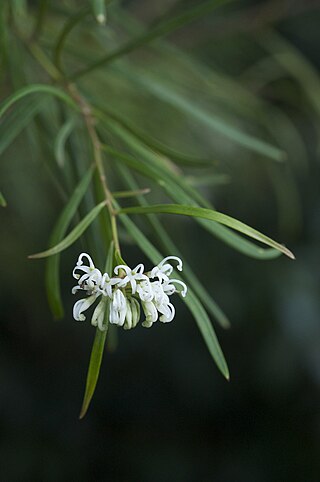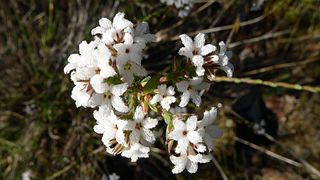
Angophora costata, commonly known as Sydney red gum, rusty gum or smooth-barked apple, is a species of tree that is endemic to eastern Australia. Reaching 30 m (100 ft) in height, the species has distinctive smooth bark that is pinkish or orange-brown when new and fades to grey with age. Its lance-shaped leaves are arranged in opposite pairs along the stems, with white or creamy white flowers appearing from October to December. The flower buds are usually arranged in groups of three, followed by ribbed, oval or bell-shaped fruit.

Grevillea linearifolia, commonly known as linear-leaf grevillea, is a species of flowering plant in the family Proteaceae and is endemic to New South Wales. It is an open, erect shrub with linear to narrowly elliptic leaves, and clusters of white flowers.

Epacris longiflora, commonly known as fuchsia heath or cigarette flower, is a plant in the family Ericaceae and is endemic to eastern Australia. It is an erect or spreading shrub with egg-shaped, pointed leaves and red tube-shaped flowers which give the plant its name longiflora and are usually present throughout the year. Its native range extends from the central coast of New South Wales to southern Queensland.

Cryptocarya obovata, commonly known as pepperberry, white walnut, long tom, she beech or purple laurel, is a species of flowering plant in the laurel family and is endemic to eastern Australia. It is a rainforest tree with oblong to egg-shaped leaves, the flowers creamy-green, tube-shaped and unpleasantly perfumed, and the fruit a spherical drupe with white or cream-coloured cotyledons.

Wilkiea hugeliana, commonly known as veiny wilkiea, common wilkiea or tetra beech, is a species of flowering plant in the family Monimiaceae, and is endemic to eastern Australia. It is a tall shrub or small tree with egg-shaped, oblong to narrowly elliptic leaves, and male and female flowers on separate plants. Male flowers have 3 or 4 stamens and female flowers have 20 to 40 carpels, and the fruit is a blackish oval drupe with a yellow to orange receptacle.

Styphelia humifusa, commonly known as native cranberry or cranberry heath, is a small prostrate shrub or groundcover in the heath family Ericaceae. The species is endemic to south-eastern Australia.

Melichrus is a genus of flowering plants in the family Ericaceae, and is endemic to eastern Australia. Plants in the genus Melichrus are shrubs with narrowly egg-shaped leaves crowded at the ends of branches and bell-shaped or urn-shaped flowers arranged singly in leaf bases, the fruit a drupe.

Melichrus urceolatus, commonly known as urn heath, honey gorse or cream urn-heath, is a species of flowering plant in the family Ericaceae and is endemic to eastern Australia. It is an erect shrub with narrowly lance-shaped leaves with deep grooves on the lower surface, white, cream-coloured or yellowish-green flowers, sometimes with a red or rose-pink tinge, and spherical greenish-white or purplish-brown fruit.

Persoonia levis, commonly known as the broad-leaved geebung, is a shrub native to New South Wales and Victoria in eastern Australia. It reaches 5 m (16 ft) in height and has dark grey papery bark and bright green asymmetrical sickle-shaped leaves up to 14 cm (5.5 in) long and 8 cm (3.2 in) wide. The small yellow flowers appear in summer and autumn, followed by small green fleshy fruit, which are classified as drupes. Within the genus Persoonia, it is a member of the Lanceolata group of 58 closely related species. P. levis interbreeds with several other species where they grow together.

Persoonia linearis, commonly known as the narrow-leaved geebung, is a shrub native to New South Wales and Victoria in eastern Australia. It reaches 3 m (9.8 ft), or occasionally 5 m (16 ft), in height and has thick, dark grey papery bark. The leaves are, as the species name suggests, more or less linear in shape, and are up to 9 cm (3.5 in) long, and 0.1 to 0.7 cm wide. The small yellow flowers appear in summer, autumn and early winter, followed by small green fleshy fruit known as drupes. Within the genus Persoonia, it is a member of the Lanceolata group of 58 closely related species. P. linearis interbreeds with several other species where they grow together.

Epacris pulchella, commonly known as wallum heath or coral heath is a species of flowering plant in the family Ericaceae and is endemic to eastern Australia. It is a slender, erect shrub with egg-shaped, pointed leaves and white or pinkish, tube-shaped flowers.

Astrotricha latifolia, known as the broad-leaf star-hair, is a species of flowering plant in the Family Araliaceae and is endemic to eastern Australia. It is a large shrub with oblong to egg-shaped or elliptic leaves, and yellowish-green flowers.

Styphelia sieberi, commonly known as prickly beard-heath, is a species of flowering plant in the heath family Ericaceae and is endemic to south-eastern continental Australia. It is an erect, densely-branched shrub with oblong to more or less egg-shaped leaves with the narrower end towards the base, and white, tube-shaped flowers arranged singly in upper leaf axils.

Micromyrtus ciliata is a species of flowering plant in the family Myrtaceae and is endemic to south-eastern continental Australia. It is a spreading to erect shrub with crowded, oblong to egg-shaped leaves and small white or pink flowers arranged singly in upper leaf axils, forming clusters on the ends of branches.

Persoonia hirsuta, commonly known as the hairy geebung or hairy persoonia, is a species of flowering plant in the family Proteaceae. It is endemic to eastern New South Wales, Australia. It is a hairy, spreading to low-lying shrub with linear, lance-shaped or spatula-shaped leaves and yellow or orange flowers arranged singly or in groups of up to ten on a rachis up to 20 mm (0.79 in) long.

Leucopogon microphyllus is a species of flowering plant in the heath family Ericaceae and is endemic to eastern Australia. It is a bushy or spreading shrub with egg-shaped leaves, sometimes with the narrower end towards the base, and compact spikes of usually four to nine white, tube-shaped flowers.

Commersonia hermanniifolia, commonly known as wrinkled kerrawang, is a species of flowering plant in the family Malvaceae and is endemic to New South Wales. It is a prostrate or trailing shrub with oblong to lance-shaped leaves that are paler on the lower surface, and flowers with five white sepals fading to pink and five pinkish petals.

Pultenaea villosa, commonly known as hairy bush-pea, is a species of flowering plant in the family Fabaceae and is endemic to eastern Australia. It is a shrub with softly-hairy foliage, narrow elliptic to linear, oblong to club-shaped leaves, and yellow-orange and reddish-brown, pea-like flowers.
Melichrus gibberagee, commonly known as narrow-leaf melichrus, is a species of flowering plant in the family Ericaceae and is endemic to a restricted part of eastern Australia. It is a small shrub with compact, narrow, more or less erect, sharply-pointed leaves, white or yellowish flowers and more or less spherical, red drupes.
Melichrus hirsutus, commonly known as hairy melichrus, is a species of flowering plant in the family Ericaceae and is endemic to a restricted part of eastern Australia. It is a shrub with many stems at the base, ascending, lance-shaped, hairy, sharply-pointed leaves, pink, tube-shaped flowers and fleshy, spherical, reddish-purple drupes.

















